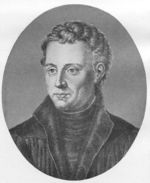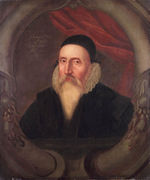Difference between revisions of "Category:Enochic Studies--1500s"
| Line 1: | Line 1: | ||
[[File:Johannes Reuchlin.jpg|thumb|150px|Johannes Reuchlin]] | [[File:Johannes Reuchlin.jpg|thumb|150px|Johannes Reuchlin]] [[File:St Stephen to the Abyssinians.jpg|thumb|150px|St Stephen to the Abyssinians]] | ||
[[File:St Stephen to the Abyssinians.jpg|thumb|150px|St Stephen to the Abyssinians]] | [[File:Guillaume Postel.jpg|thumb|150px|Guillaume Postel]] [[File:John Dee.jpg|thumb|150px|John Dee]] | ||
[[File:Guillaume Postel.jpg|thumb|150px|Guillaume Postel]] | |||
[[File:John Dee.jpg|thumb|150px|John Dee]] | |||
* [[:Category:Enochic Studies|BACK to the ENOCHIC STUDIES--INDEX]] | * [[:Category:Enochic Studies|BACK to the ENOCHIC STUDIES--INDEX]] | ||
Revision as of 07:18, 5 April 2014
Enochic Studies in the 1500s--Works and Authors
< ... -- 1400s -- 1500s -- 1600s -- 1700s -- 1800s -- 1850s -- 1900s -- 1910s -- 1920s -- 1930s -- 1940s -- 1950s -- 1960s -- 1970s -- 1980s -- 1990s -- 2000s -- 2010s -- ... >
Overview
At the turn of the 16th century the book of Enoch still remained an elusive presence. In De Verbo mirifico (1494) German Hebraist Johannes Reuchlin repeated the complaint, expressed by Giovanni Pico della Mirandola in his Apologia (1487), against the falsehood and ignorance often hidden behind such splendid titles as the books of Solomon and the books of Enoch. Reuchlin was familiar with the activities of the Hospitium fratrum Indianorum established in Rome in 1481 under Pope Sixtus IV who gave the ancient church and monastery of St. Stephen in Vatican to Ethiopian pilgrims from Jerusalem (the church was renamed Ecclesia fratum Indianorum and is still today known as St Stephen to the Abyssinians). The presence of Ethiopian pilgrims is attested in Roma since 1315 and a delegation of Ethiopic priests attended the Council of Florence in 1431, but the establishment of the Hospitium fratum Indianorum made it the first center of Ethiopic culture in Europe. Reuchlin visited Rome several times and knew well the cultural activities at the Hospitium as he was in correspondence with Johannes Potken who in Rome in 1513 co-edited with the Ethiopian friar Thomas Walda Samuel the first book ever printed in Ethiopic (Alphabetum seu potius syllabarium literarum Chaldaerarum, Rome, 1513). Neither Reuchlin nor Pico della Mirandola before him, however, seemed to be aware of any special connection between the Book of Enoch and Ethiopia. In De arte cabalistica (1517) Reuchlin still implied that Pico had the book of Enoch as one of the "seventy secret books of Ezra," ignoring that Pico had instead only a Hebrew ms (and Latin translation) of Menahem Recanati's work, of which the editio princeps was published in 1523 and a commentary by Mordecai Jaffe appeared in 1595.
The figure of Enoch remained popular in esoteric circles all around Europe. In 1530 the Venetian alchemist Giovanni Agostino Panteo published 26 charachters purporting to be the pre-Flood "Enochian" alphabet. This alphabet was not the result of philological studies but of magical knowledge; after all, the art of alchemy was believed to derive from the fallen angels and be inscribed after the Flood in the Book of Chemes, who was identified with Cam, the son of Noah and descendent of Enoch.
Expectations of the "return" of Enoch continued to be very strong in millenaristic circles. In 1524, Martin Luther himself had to intervene to disprove these beliefs in his commentary on the Letter to Jude. The most notable incident occurred in 1533-34; after Melchior Hofmann predicted that Christ would return to earth, the anabaptist Jan Matthys ruled the city of Munster, Germany as the "New Jerusalem," declaring that he was the prophet Enoch redivivus. Matthys died during the siege of the city, when on Easter Sunday made a sally forth with thirty followers, convinced that Judgment Day had come.
First evidence of the existence of an actual book of Enoch in Ethiopia came in mid-16th century by Guillaume Postel. In 1551 in De Etruriae regionis Guillaume declared that the Enoch's prophesies made before the Flood were preserved in the archives of the Queen of Sheba and that to this day they were believed to be canonical scripture in Ethiopia. In 1553 he wrote in his De originibus that in Rome (most likely, in 1547) he had met an Abyssinian priest who illustrated him the content of 1 Enoch. According to Luis de Urreta, the Librarian of the Vatican Apostolic Library Guglielmo Sirleto also was made aware of the existence of the Book of Enoch in Ethiopia by two friers who visited the country (in 1579?) as members of a delegation sent by Pope Gregory XIII to the Ethiopian King. But no progress was made in the recovery of the actual content of the book of Enoch.
The idea that magic and alchemy could provide a shortcut continued to fascinate European intellectual circles. The works of Panteo and Postel inspired British alchemist John Dee to team with visionary Edward Kelley in the search for the lost book. In 1583 they claimed to have received from the archangel Michael portions of the Book of Enoch written in the angelic (or "Enochian") alphabet that Enoch himself used to communicate with the angels.
@2014, Gabriele Boccaccini, University of Michigan
Pages in category "Enochic Studies--1500s"
The following 20 pages are in this category, out of 20 total.
1
- Orlando furioso (The Frenzy of Orlando / 1516 Ariosto), Italian poem
- De arte cabalistica (1517 Reuchlin), book
- Testamenta duodecim patriarcharum filiorum Jacob (1520 Grosseteste), book
- פירוש על התורה (Commentary to the Torah / 1523 Recanati), book (Hebrew / ed. princeps)
- Die ander Epistel S. Petri und eyne S. Judas (1524 Luther), book
- De harmonia mundi totīus cantica tria (1525 Zorzi), book
- Commentarii in Epistolas catholicas (1527 Lefèvre), book
- Voarchadumia contra alchimiam (1530 Panteo), book
- Pentagruel et Gargantua (1532-34 Rabelais), novel
- An Exposition vpon the Epistle of Jude ye Apostle of Christ (1549 Ridley), book
- Commentaria in omnes divi Pauli, et alias septem canonicas epistola (1551 Pellicanus), book
- De Etruriae regionis (1551 Postel), book
- De originibus seu de varia ... Latino incognita historia totius Orientis (1553 Postel), book
- Scriptorum illustrium maioris Brytanniae posterior pars (1559 Bale), book
- The Testaments of the Twelve Patriarchs, the Sonnes of Jacob (1574 Gilby), book
- Vite dei santi e beati del sacro ordine dei frati predicatori (1577 Razzi), book
- Liber mysteriorum (1583 Dee, Kelley), ms
- לבוש מלכות (Robes of Royalty / 1595 Jaffe), book (Hebrew)



